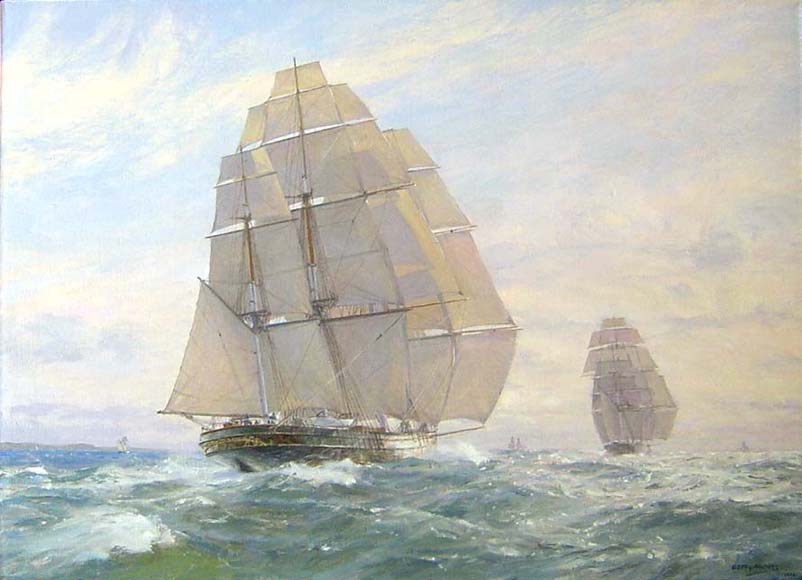Art Marine
Ariel & Taeping - Geoff Hunt
Ariel & Taeping - Geoff Hunt
Couldn't load pickup availability
Despite the significant technological developments in steam navigation during the third quarter of the nineteenth century, the ships which constantly attracted most public attention in that era were the legendary tea clippers which, although entirely powered by the wind, were unquestionably the fastest commercial sailing vessels the world had ever seen. Two in particular of these remarkable thoroughbreds - 'Ariel' and 'Taeping' - were amongst the most celebrated of their breed and 'Ariel' was even referred to as "the fastest thing the wind ever drove through the water".
The so-called 'clippers' of the 1850s were replaced, in the early 1860s, with a new generation of composite ships generically known as the 'Greenock Model', the lines of which were designed by Robert Steele, one of the foremost shipbuilders on the Clyde.
In 1863, after completing his 'Serica' and 'Young Lochinvar' entirely in wood, Steele laid down and built his first composite clipper [of wooden planks laid upon iron frames] and named her 'Taeping'. Registered at 767 tons and measuring 184 feet in length with a 31 foot beam, she proved a huge success thanks to her uncanny ability to excel in light winds as well as anything stronger. After a good maiden voyage in 1864, despite being disabled in a typhoon off Formosa and being forced into Amoy for repairs, she ran home in 104 days in 1865 only to eclipse that achievement with her memorable 99-day performance the following year [see below]. First home with the new season's tea in 1867 and again in 1870, her final voyage the next year ended in premature disaster when she was wrecked on Ladd's Reef in the South China Sea on 22nd September 1871.
Like 'Taeping', 'Ariel' was also the product of Robert Steele's yards at Greenock and was launched on 19th June 1865. Registered at 852 tons and 198 feet in length with a 34 foot beam, she too proved extraordinarily fast and fulfilled all the expectations that accompanied Steele's clippers right from the start. Ordered by Shaw, Lowther & Maxton of London, she and 'Taeping' shared the honour of being first home with the 1866 tea crop whilst her next passage out - 79 days from Gravesend to Hong Kong (pilot to pilot) - was the fastest ever recorded. In the 1870-71 season she carried tea from Yokohama to New York but her brilliant career was cut short when she disappeared at sea sometime after leaving London, bound for Sydney, on 31st January 1872.
The Great Tea Race of 1866
By the mid-1860s, the clippers' annual homeward passage with the new season's tea crop had become a race and the contest fought out in 1866 became the most famous of them all. At the end of May that year, four of the tea trade's fastest carriers - 'Ariel', 'Fiery Cross', 'Serica' and 'Taeping' - were all loading cargo at Foochow; 'Ariel' cleared the dockside first but minor problems with tugs and tides in the estuary delayed all four until, by noon on 30th May, the quartet of contenders were all in open water. The run home to England proved heroic, with the four ships passing and re-passing each other on many occasions, but by the time 'Ariel' and 'Taeping' reached the Scillies, they were out in front with 'Serica' a few hours behind them. Practically neck-and-neck, the two leading clippers raced up the English Channel logging 14 knots for much of 5th September. At 8 o'clock the next morning, 'Ariel' signalled her number off Deal with 'Taeping' only ten minutes astern of her. Reaching the Nore, 'Taeping' picked up the better of the two available tugs and arrived off Gravesend to await the tide just ahead of her running mate. Still a race to the last, 'Taeping' - drawing less water than her rival - docked in London at 9.47pm., 'Ariel' tied up at 10.13pm. and 'Serica' got in at 11.30pm., just as the dock gates were closing. It was a breathtaking finish to the 99-day dash across the world and the closest result possible to a dead heat.
Signed and numbered limited edition print.
On paper - Edition of 550 including 25 remarques -
Image size: 12 x 16.25 inches (30 x 41cm)
Paper Size: 17 x 20.5 inches (43cm x 52cm)
On Canvas - Edition of 195.
Image Size: 16 x 22 inches (40.5cm x 56cm)
Share


